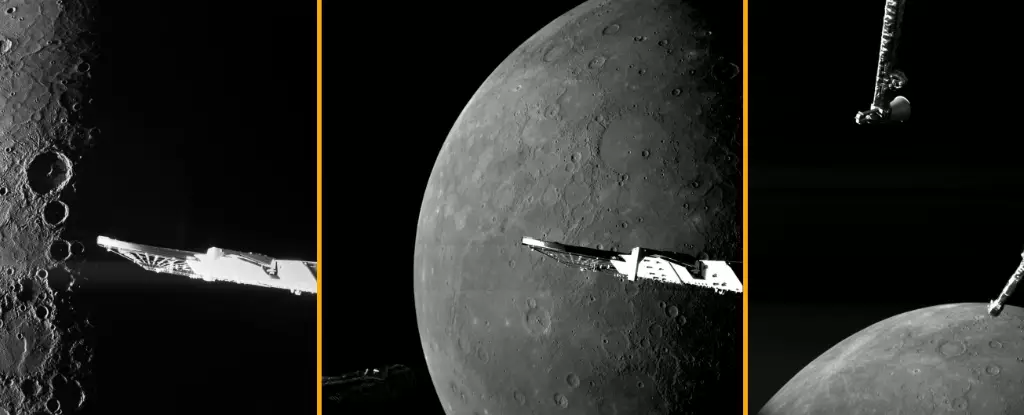In an unparalleled display of space exploration, ESA’s BepiColombo transfer probe has recently emerged from its final flyby of Mercury, the closest planet to our solar system’s sun. At just 295 kilometers from the planet’s surface, BepiColombo has captured extraordinary images that reveal Mercury’s harsh and tumultuous environment. These images not only depict the planet’s extreme temperature contrasts but also unveil darkened regions that may harbor significant geological secrets, including possible deposits of ice. The current phase of the BepiColombo mission sets the stage for a deeper investigation into Mercury’s mysteries over the coming years.
Mercury is a planet of stark contrasts. Its proximity to the sun subjects it to intense solar radiation and extreme temperatures. During the day, irradiated surfaces can soar to an astounding 430 degrees Celsius, while at night, the temperatures plummet to a frigid minus 180 degrees Celsius. The planet’s tenuous atmosphere, composed primarily of trace gases, is constantly being replenished by impacts from meteoroids and the influx of solar plasma. This duality of scorching heat and frigid shadows presents a striking visual dichotomy in the images returned from the flyby.
Noteworthy are the regions perpetually shrouded in darkness, where scientists suspect ice could exist—a remarkable find given Mercury’s surface conditions. As Geraint Jones, ESA’s project scientist for BepiColombo, noted, this ice-laden darkness preserves clues from the planet’s geological history that could be pivotal for our understanding of not just Mercury’s past but also its potential future.
Revealing the Geological Diversity
The images from the recent flyby not only showcase the extreme temperature variations but provide a closer look at Mercury’s complex surface features. One compelling feature is Nathair Facula, believed to be the remnant of the largest explosive volcanic event known on the planet. The scale of the volcanic activity, marked by a vent disc of around 40 kilometers in diameter, implies an active geological history that contrasts starkly with the planet’s seemingly desolate landscape today.
Nearby, Fonteyn crater emerges as a younger feature, having formed approximately 300 million years ago. These surface distinctions hint at a dynamic geological timeline that may include volcanic activity and significant impacts that have shaped Mercury into the unique world it is today. As BepiColombo’s instruments catalog these observations, they furnish astronomers with valuable data that challenge previous perceptions of Mercury as a static, inhospitable world.
The Quest for Understanding Mercury’s Core Secrets
Launched in October 2018, BepiColombo is a joint initiative of the European Space Agency and the Japan Aerospace Exploration Agency, designed to investigate Mercury’s enigmatic magnetosphere and gaseous exosphere. One of the most intriguing questions surrounds Mercury’s magnetic field, an anomaly given its proximity to the sun and lack of a substantial atmosphere. This magnetic field suggests underlying complexities, possibly linked to a partially molten core or geological processes currently unknown to scientists.
Speculations abound regarding the nature of Mercury’s core, which could be composed of a carbon-rich substance potentially forming a layer of diamond beneath the surface. The mission aims to fill in the gaps of our understanding by providing data that could offer insights into the geological and magnetic phenomena that define this elusive planet.
Looking ahead, the BepiColombo mission is far from over. In 2026, the Mercury Transfer Module is anticipated to release two orbiters: ESA’s Mercury Planetary Orbiter and the Japan Aerospace Exploration Agency’s Mercury Magnetospheric Orbiter. These vehicles will begin their critical roles in collecting extensive data about Mercury’s atmosphere, surface conditions, and magnetic field. While they won’t come closer than 480 kilometers from the surface, the insights gathered will be invaluable for piecing together the many mysteries surrounding Mercury.
As BepiColombo prepares for its future explorations, the legacy of its current discoveries stands as a testament to human ingenuity and insatiable curiosity. Through these efforts, we inch closer to comprehending the myriad complexities of our solar neighborhoods. Mercury, once perceived as merely a scorched rock, is starting to reveal its many secrets—secrets that could reshape our understanding of planet formation and evolution in our solar system and beyond.


Leave a Reply